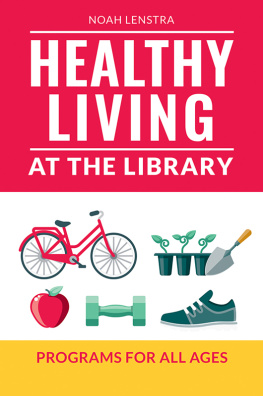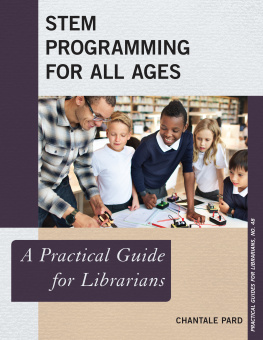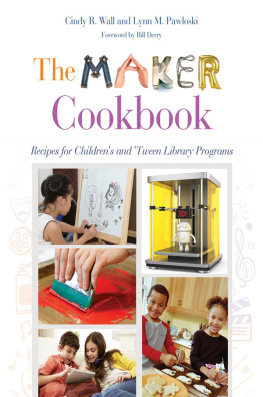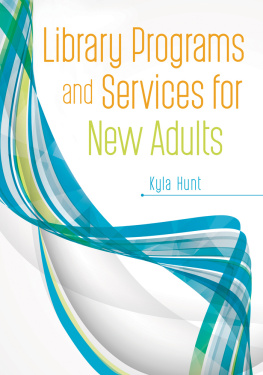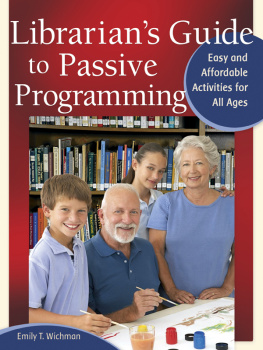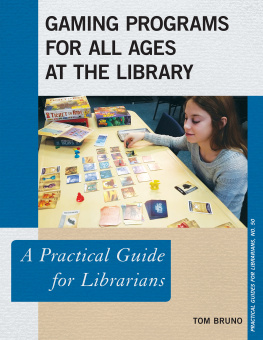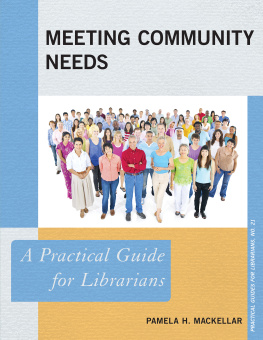More Praise for Healthy Living at the Library: Programs for All Ages:
With enthusiasm, generosity, and a formidable knowledge base, Noah Lenstra makes the case for library promotion of public health and provides librarians much inspiration and practical advice. Health, wellness, nutrition, and movement programming and related activities, from serving summer meals to lending bikes, arent mission-stretching add-ons; rather, they are intrinsic to the purpose of the library and tremendously beneficial to participants. A wide array of examples from libraries around the United States and worldwide demonstrate that library involvement makes healthy living practices accessible and inclusive while enhancing the librarys role in the community.
Janet Ingraham Dwyer, Library Consultant, State Library of Ohio
Healthy Living at the Library provides a wealth of examples helpful for any size library to start or add to their healthy living initiatives. What sets this book apart is the perspective provided for each example. Readers are not told what should be done; rather, they are given a variety of perspectives from librarians around the world who have been doing the work for years now of integrating healthy living into their librarys programming efforts. Librarians can then take the ideas and adapt them to suit their communitys needs. As someone who has integrated a variety of health-related programming at a joint-use library (serving public patrons as well as college students), I found myself agreeing with the approaches offered on how to get started as well as jotting down additional ideas of how to move forward strategically with future efforts. This book will be invaluable for any librarian wishing to increase the health education opportunities of their community through library programming.
Kendra Auberry, Librarian/Assistant Professor, Indian River State College
Libraries are natural partners in encouraging healthy living for our communities. Based on my positive experiences with Lets Move Museums and Gardens promoting healthy practices in cultural spaces, I am thrilled to see similar success in this exciting compilation of health-related activities in our libraries.
Susan Hildreth, Former Director, Institute of Museum and Library Services
Implementing physical health and wellness programs at the library allow it to be a one-stop shop to meet the needs of the community; patron services can be enhanced by increasing literacy and health and wellness activities for patrons.
Michelle Bennett-Copeland, Youth Services Manager/Central Fulton County Library System
Healthy Living at the Library
Programs for All Ages
Noah Lenstra

Copyright 2020 by Noah Lenstra
All rights reserved. No part of this publication may be reproduced, stored in a retrieval system, or transmitted, in any form or by any means, electronic, mechanical, photocopying, recording, or otherwise, except for the inclusion of brief quotations in a review, without prior permission in writing from the publisher.
Library of Congress Cataloging-in-Publication Data
Library of Congress Cataloging in Publication Control Number: 2020933791
ISBN: 978-1-4408-6314-1 (paperback)
978-1-4408-6315-8 (ebook)
242322212012345
This book is also available as an eBook.
Libraries Unlimited
An Imprint of ABC-CLIO, LLC
ABC-CLIO, LLC
147 Castilian Drive
Santa Barbara, California 93117
www.abc-clio.com
This book is printed on acid-free paper 
Manufactured in the United States of America
Contents
What factors cause one person to be healthier than another over time? Some thingsgenetics, for instanceare beyond our personal control, but little things we do throughout our daily lives can, over time, have huge impacts. This book gives you the tools you need to support healthy living at your library by developing programs and partnerships that will improve the choices, habits, and environments that together contribute to our overall health.
Since health is such a bigand frequently misunderstoodtopic, lets start with a definition. According to public health researchers, health means physical and mental health status and well-being, distinguished from health care (Braveman et al. 2017, 3). This definition has since been incorporated into the planning framework for Developing Healthy People 2030, the action plan for the U.S. Office of Disease Prevention and Health Promotion. Why is this important? Because this book does not, for the most part, focus on the formal health-care sector. That is indeed an important topic, but here we are instead focused on healthy living practices and not on engagement with health care.
Medical professionals and policy makers urge us to make healthy living a conscious and deliberate part of our lives. That means making conscious and deliberate choices about how we move and how we eat. As well see below, eating and moving are educational acts. Librarians of all types answer this call to support the lifelong learning of healthy living habits by offering everything from StoryWalk to cooking programs, and even Zumba breaks during academic finals. There is no one way to practice healthy living. There is no one way to promote healthy living at your library. This book will help you discover, develop, and implement your librarys path.
How you support healthy living at your library will look at least slightly different from what every other library does. This heterogeneity is in fact what policy makers recommend. Physical Activity Guidelines for Americans, released by the Centers for Disease Control and Prevention (CDC) in September 2018 focuses on the idea that you should Move Your Way:
Walk. Run. Dance. Play. Whats your move?
Everyone needs physical activity to stay healthy. But it can be hard to find the time in your busy routine. No matter who you are, you can find safe, fun ways to get activeto move your way. (U.S. HHS 2018, para. 1)
National recommendations for healthy eating are remarkably similar. The Choose My Plate initiative launched as part of the Dietary Guidelines for Americans, 20152020, focuses on the simple idea that healthful meals have a balance of vegetables, fruits, grains, protein, and dairy. This simple message replaces more complicated food pyramids and other eating restrictions. Instead, the idea is that the path to healthy eating is paved by finding your healthy eating style and building it throughout your lifetime (USDA 2019).
Move your way. Find your healthy eating style. Those who spend a lot of time thinking about healthy living and how to support it find that they need to make it theirs. Start now. Today. Yes, you. If you want to do healthy living programs at your library, you need to start with yourself (and your library, more generallymore on that later!).
Ive been studying this topic during the vast majority of my waking hours since September 2016. In this work, I look for patterns in library programs oriented toward healthy living. I ask, How did this tiny library with no programming budget develop such an impactful healthy living program? And why is this library doing so much, while the library down the road is barely doing anything at all? This book is about those patterns. These findings have been field-tested at public health conferences and in dozens of presentations at state and national library conferences, in continuing education webinars, in blog posts written for the American Library Association, and in peer-reviewed academic articles, all of which can be accessed online if youd like to dig deeper into anything covered in this book. Or just email me with questions: well go over how to get involved in these discussions.

